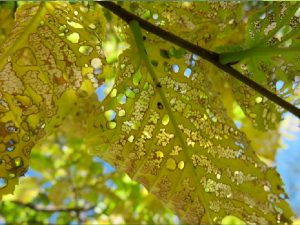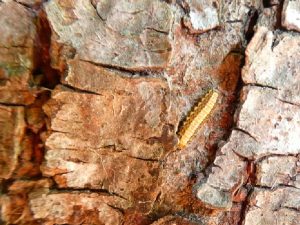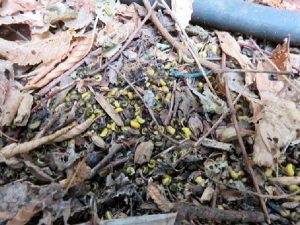
Elm Leaf Beetle
Matthew Roderick 15 January 0 CommentsElm Leaf Beetle is an insect pest of several Elm species in Europe and America. It has been present in Adelaide from 2011. The beetle’s life cycle can be summarised as follows:
- The beetles hibernate within a pupal case in winter in sheltered places in the garden and home.
- The adult beetles emerge in spring (late September/early October), feeding on leaves causing shot-hole damage.
- The adult beetles mate and then lay their first round of eggs in October and November (double rows of very small yellow eggs on the underside of leaves).
- The eggs hatch and a small larvae (caterpillars) feeds on the leaves, leaving a skeletonisation/lacy pattern. There are three larval stages, which cause most of the leaf damage.
- The 3rd larval stage migrates down the trunk in summer to find a place to pupate and emerge as new beetles.
- The beetle’s life cycle repeats and 2-3 generations are possible in a year.
How does it affect my tree?
Elm Leaf Beetle infestations vary in severity from year to year due to seasonal conditions. The level of damage can vary from minor (only a small number of leaves affected with minor damage) to major (all leaves extensively damaged). The damage to the tree is largely aesthetic. Light infestations are unlikely to have a significant impact on the long term health of your Elm. Severe infestations on a regular basis have the potential to affect long term health to varying degrees. This will depend on the underlying health level of your tree. Beetles can invade the home and become a nuisance.
What trees are affected?
Elm leaf beetle affects European Elm species including English Elm (Ulmus procera), Dutch Elm (Ulmus x hollandica), Golden Elm (Ulmus glabra ‘Lutescens’), Wych Elm (Ulmus glabra) and others. It has also been identified in Japanese Zelkova (Zelkova serrata). The Asian Elm species such as the Chinese Elm (Ulmus parvifolia) and Ulmus ‘Sapporo Autumn Gold’ have been less affected.
Managing Elm Leaf Beetle
An integrated approach to managing tree health and the pest is the recommended approach. This includes a combination of cultural practices, physical control and chemical control, as described below. Greater success is best achieved where all three strategies are used together.
Cultural practices
The following guidelines should be implemented to maintain the health of your tree:
- Avoid any root disturbance within the dripline of the tree.
- Reduce the extent of hard surfaces, paving and plant competition under your tree if possible.
- Maintain adequate levels of mulch around your tree. i.e., 75mm thick layer of organic mulch.
- Maintain adequate irrigation over the areas around your tree during warmer months. Apply water less frequently for a long duration. This is more beneficial than frequent, but short irrigation periods.
- Avoid heavy pruning and poor pruning practices.
Chemical control – Trunk injection
- Trunk injection is the preferred method of treatment at present.
- A small amount of systemic insecticide (SilvaShield™ containing Imidacloprid) is injected directly into the trunk.
- There is less ‘off target’ damage, where only insects living and feeding in the tree are affected (including beneficial insects). This is in contrast to spraying or soil injection where more ‘off target’ insects (and other organisms) may be affected in the soil and surrounding area.
- There is minor trunk wounding at the injection sites. Therefore, treatments should be spread out over time to minimise cumulative trunk damage.
- Trunk injection equipment is disinfected between trees to prevent disease transmission between trees.
Physical control
- Physically sweeping up the yellow pupal cases around the base of the tree at regular intervals helps to reduce the population of insects that can emerge and fly back up into the tree.
- Interrupting the larvae’s migration down the trunk can also assist in reducing insect numbers. A range of trunk banding methods may assist, such as horticultural glues and sticky banding.
What should I expect?
The uptake of the chemical depends on the tree’s transpiration rate, which in turn is affected by weather, soil moisture levels, level of existing leaf damage, tree health and other various factors. It can take up to seven days to spread throughout the crown. Branching habit can affect how evenly the chemical is distributed throughout the tree, particularly in Golden Elm’s.
Given the feeding habit of the of the insect, its ability to fly between trees, its ability to be transported by people and vehicles and the fact that not all trees in an area will be treated, it is expected that adult insects will reach your tree, feed and lay eggs, causing some minor damage to leaves. The chemical treatment is expected to reduce the insect population to low levels, keeping tree damage below an acceptable threshold. This treatment is not expected to eradicate the pest or prevent all insect damage.
The treatment should be effective for about 2-3 years. Regular treatments every three years should provide suitable protection from the insect. More frequent treatments may be required, depending on the presence and level of reinfestation, and your tolerance to leaf damage. Some minor damage to treated trees is unavoidable, normal, and should not be a cause of concern.




Leave A Comment
Your email address will not be published. Required fields are marked *
You must be logged in to post a comment.